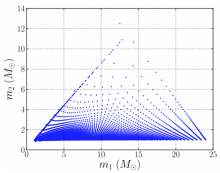
Abstract
In the world of data analysis, we often think of astrophysical phenomena in terms of the properties of their signals. For that reason, people expecting to hear about black hole inspirals are sometimes surprised to walk into a room full of gravitational wave data analysts and hear us talking about „compact binary coalescences” or „CBCs”. (In fact, the LSC’s inspiral analysis group renamed itself the CBC group a few years into the Initial LIGO science runs.) There are good reasons for this terminology. First, the orbital signatures of black holes are not really that different from those of neutron stars, so it makes more sense to think of binaries of compact objects; their gravitational wave signatures are basically those of orbiting point masses. White dwarfs are also considered compact objects astrophysically, but they’re not compact enough to generate the sort of inspiral signals we are looking for with ground-based detectors. Second, what we expect to see from some compact object binaries is not just the inspiral, but the full coalescence, which can be divided into inspiral, merger and ringdown.